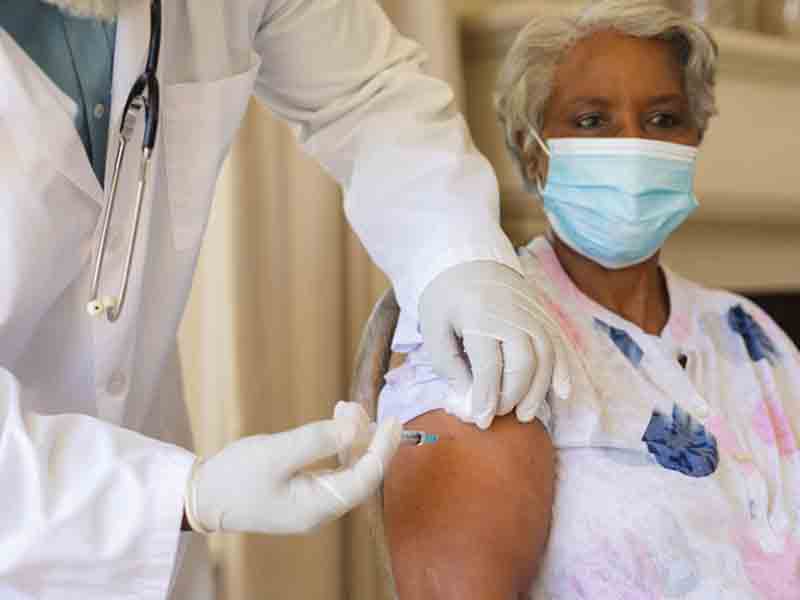Achieving Vaccine Equity
CME Aims to Boost Immunization Rates in Black Communities
July 22, 2021, 3:12 p.m. Staff Writer — Every year, tens of thousands of American adults experience a serious health condition, require hospitalization or die from an infectious disease for which a vaccine is readily available. While vaccination rates among American adults are comparatively low, data from the Office of Minority Health indicate that overall vaccination rates among African American adults are lower than white adults. In particular, OMH has cited data showing that just over 41% of African American adults received the influenza shot during the 2019-20 influenza season compared with nearly 53% of white adults.

Thanks to a cooperative agreement and funding provided by the CDC, the Academy has rolled out an ambitious CME program intended to stop vaccine disparity in its tracks and increase adult immunization rates in African American patients. The program, which is available to family physicians and other clinicians at no charge, combines performance improvement activities with a webcast and downloadable tools, and allows participants to earn up to 21 CME credits.
“Vaccination rates in African American communities are influenced by social determinants of health such as the availability of health care facilities and physicians in the neighborhood, health insurance coverage, health literacy and transportation,” said Denée Moore, M.D., an assistant professor in the Department of Family Medicine and Population Health at Virginia Commonwealth University School of Medicine in Richmond and a faculty member for the program.
“Also, gaps in vaccination data and vaccine availability can impact immunization rates in these communities,” Moore continued. “Family physicians play a key role in delivering preventive care services to patients, so it is important for them to be aware of low immunization rates in this population and actively work to address this problem. This CME activity will help family physicians and their practices recognize barriers to immunization and identify and implement interventions to improve immunization rates.”
Story Highlights
Inside Look
The “Increasing Adult Immunization Rates Among African American Communities: A Performance Improvement Activities Solution” program is divided into two components.
The first component is a webcast presented by Moore. It provides listeners with an overview of immunization statistics in African American communities, discusses barriers to immunization, reviews the latest clinical recommendations for routine adult immunizations, and suggests interventions for improving immunization rates that clinicians can identify and implement in practice.
Participants can also download and view an accompanying PowerPoint presentation that supplements the webcast with additional resources.
The second component is a performance improvement activity comprised of three stages: a self-assessment process, evaluation of current performance and implementation of a plan to improve immunization rates based on the self-assessment, and measurement of the effects of the improvement plan and interventions.
Each stage contains related forms that participants can view or download to help them complete the performance improvement activity. In addition, the activity includes a data collection form and guidance document that physicians can use in their practices, and links to resources such as the Academy’s Office Champions Quality Improvement Model and the AAFP’s Conversations: Improving Adult Immunization Rates Using Simple and Strong Recommendations video series.
After completing the activity, participants should be able to
- reflect on their current medical skills and practice environment through chart audits, self-assessment and patient surveys that measure key indicators of high-quality care for immunizations for African American patients;
- identify practice deficits that impact performance related to immunization rates of African American patients, then identify and execute evidence-based changes that consistently support patient-centered outcomes for immunizations for African American patients; and
- reflect on the effect of the evidence-based changes on practice performance, and modify changes as needed to support long-term, ongoing, continuous improvement.
Individuals who complete the session can claim up to 21 CME credits — 20 performance improvement AAFP Prescribed credits for the performance improvement activity and one enduring material/self-study AAFP Prescribed credit for the webcast.
Successful completion of the activity, which includes participation in the evaluation component, also enables the participant to earn 20 Performance Improvement points in the American Board of Family Medicine’s Family Medicine Certification program.
The activity has also been designated for a maximum of 21 AMA PRA Category 1 credits.
Additional Content for Patients
Through the cooperative agreement, the Academy has also created several “Doctors’ Notes” segments on its patient-centered site, familydoctor.org. These segments feature first-hand accounts from family physicians that emphasize the importance of the doctor-patient relationship and could prove useful in helping patients get the information they need on vaccines. They include
- “Which Vaccinations Do I Really Need?” by Amra Resic, M.D., a 2017 AAFP Vaccine Science Fellow and clinician at BayCare Medical Group in Palm Harbor, Fla.;
- “Don’t Miss Your (Flu) Shot” by Michele Zawora, M.D., an assistant professor in the Department of Family and Community Medicine at Sidney Kimmel Medical College at Thomas Jefferson University in Philadelphia; and
- “Unsure About the COVID-19 Vaccine? Talk to Your Family Doctor” by Jennifer Hanna, D.O., a practicing family physician and core faculty member at Ascension Macomb-Oakland Hospital in Warren, Mich.
Familydoctor.org also has patient materials that discuss related topics, such as flu risks and chronic conditions and flu risks in racial minorities.